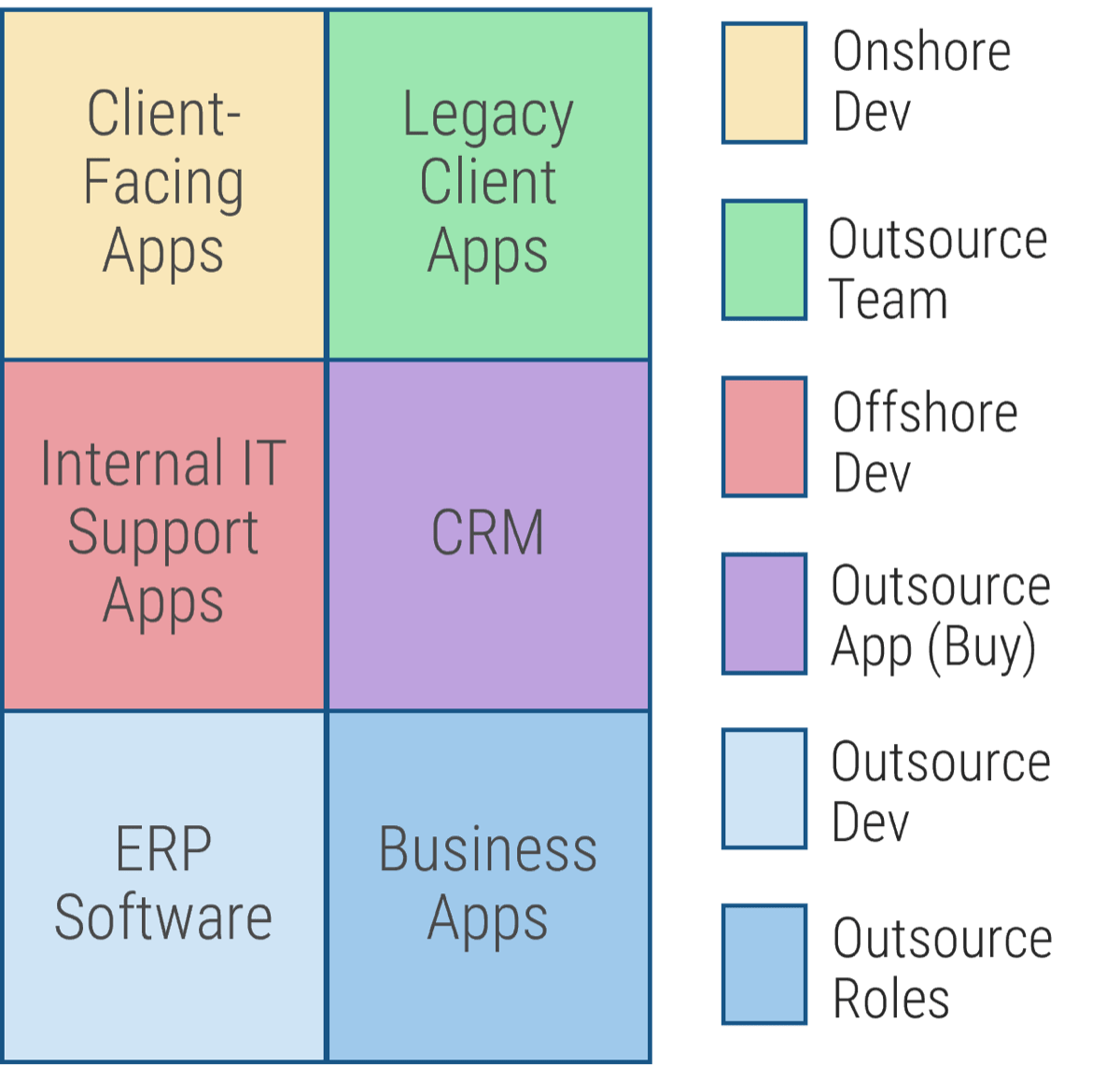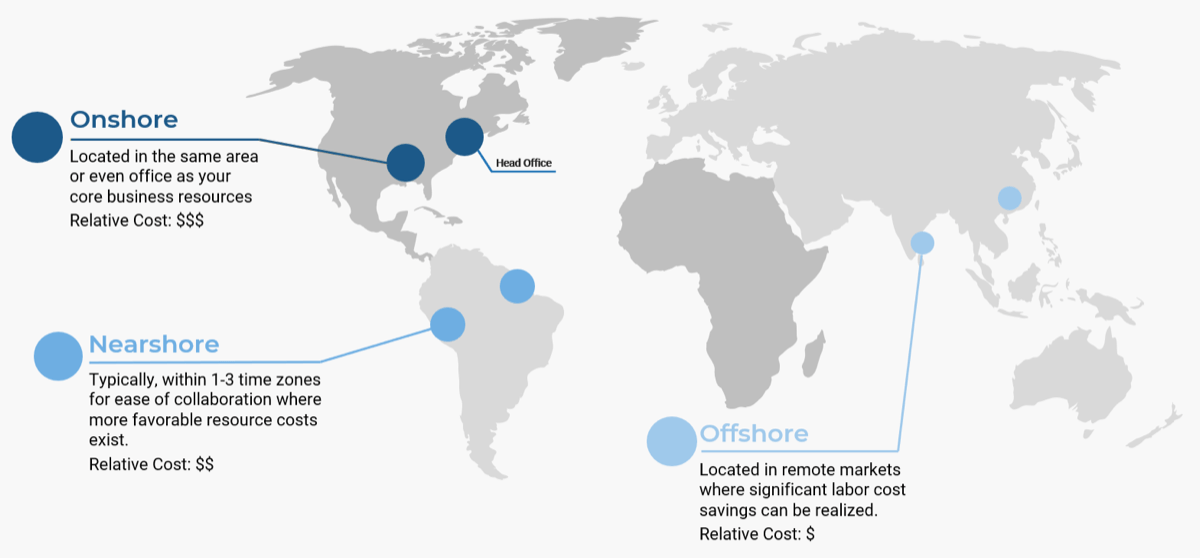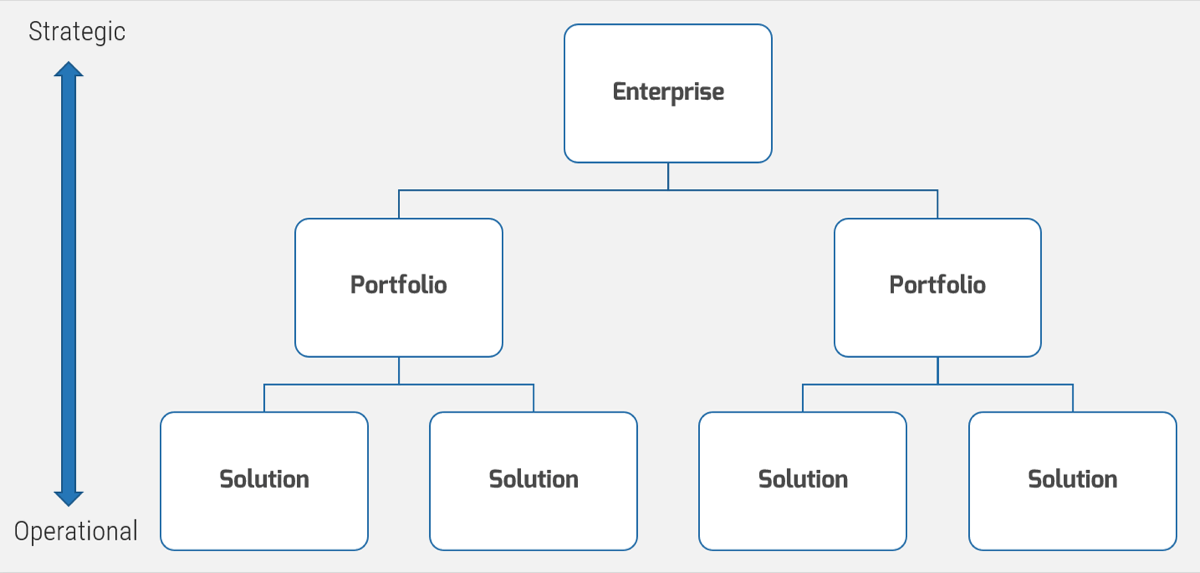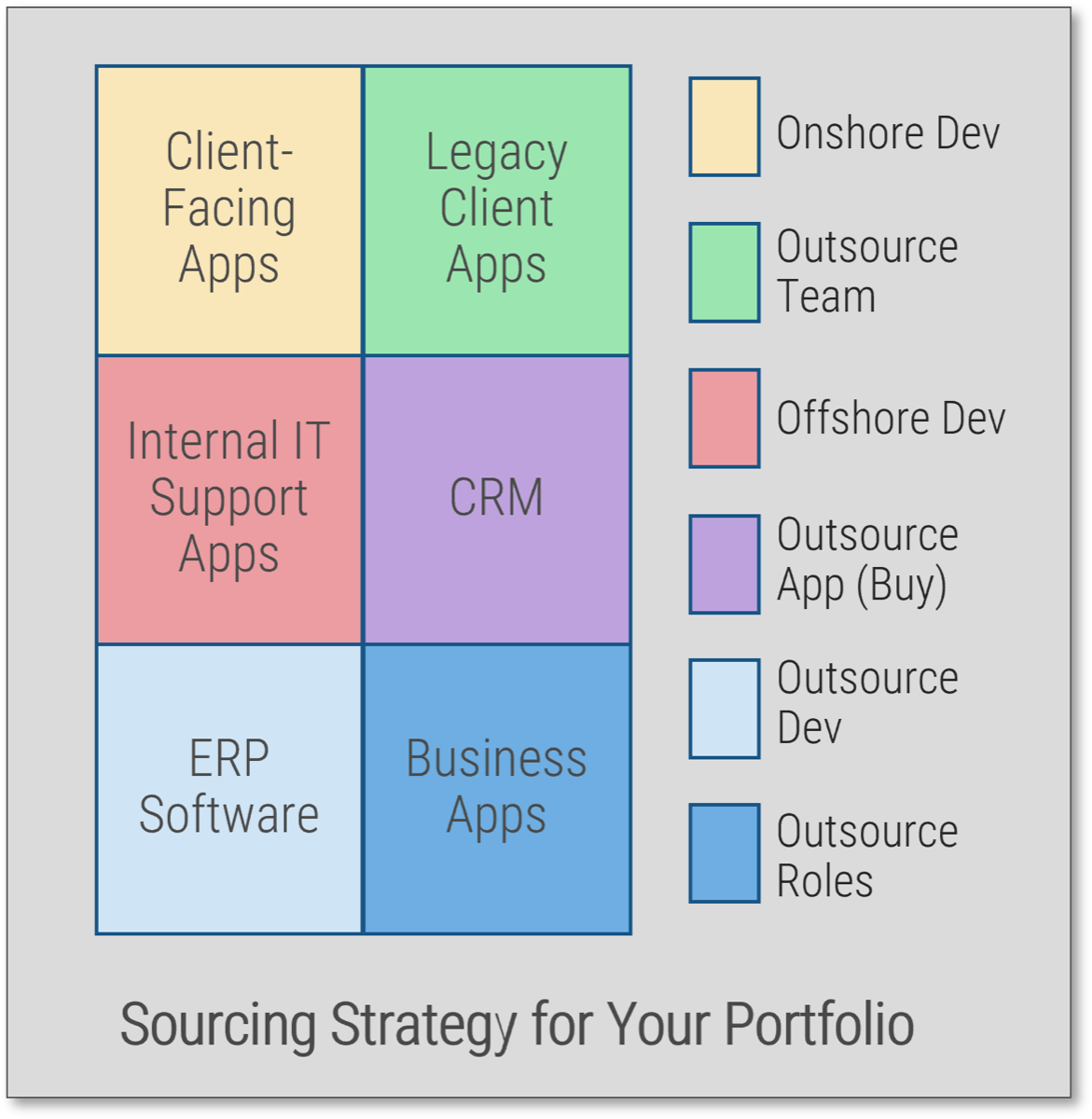Define a Sourcing Strategy for Your Development Team

- Hiring quality development team resources is becoming increasingly difficult and costly in most domestic markets.
- Firms are seeking to do more with less and increase their development team throughput.
- Globalization and increased competition are driving a need for more innovation in your applications.
- Firms want more cost certainty and tighter control of their development investment.
Our Advice
Critical Insight
- Choosing the right sourcing strategy is not just a question of technical skills! Successful sourcing is based on matching your organization’s culture, knowledge, and experiences to the right choice of internal or external partnership.
Impact and Result
- We will help you build a sourcing strategy document for your application portfolio.
- We will examine your portfolio and organization from three different perspectives to enable you to determine the right approach:
- From a business perspective, reliance on the business, strategic value of the product, and maturity of product ownership are critical.
- From an organizational perspective, you must examine your culture for communication processes, conflict resolution methods, vendor management skills, and geographic coverage.
- From a technical perspective, consider integration complexity, environmental complexity, and testing processes.
Define a Sourcing Strategy for Your Development Team Research & Tools
Besides the small introduction, subscribers and consulting clients within this management domain have access to:
1. Define a Sourcing Strategy for Your Development Team Storyboard – A guide to help you choose the right resourcing strategy to keep pace with your rapidly changing application and development needs.
This project will help you define a sourcing strategy for your application development team by assessing key factors about your products and your organization, including critical business, technical, and organizational factors. Use this analysis to select the optimal sourcing strategy for each situation.
- Define a Sourcing Strategy for Your Development Team Storyboard
2. Define a Sourcing Strategy Workbook – A tool to capture the results of activities to build your sourcing strategy.
This workbook is designed to capture the results of the activities in the storyboard. Each worksheet corresponds with an activity from the deck. The workbook is also a living artifact that should be updated periodically as the needs of your team and organization change.
- Define a Sourcing Strategy Workbook
Further reading
Define a Sourcing Strategy for Your Development Team
Choose the right resourcing strategy to keep pace with your rapidly changing application and development needs.
Analyst Perspective
Choosing the right sourcing strategy for your development team is about assessing your technical situation, your business needs, your organizational culture, and your ability to manage partners!

Firms today are under continuous pressure to innovate and deliver new features to market faster while at the same time controlling costs. This has increased the need for higher throughput in their development teams along with a broadening of skills and knowledge. In the face of these challenges, there is a new focus on how firms source their development function. Should they continue to hire internally, offshore, or outsource? How do they decide which strategy is the right fit?
Info-Tech’s research shows that the sourcing strategy considerations have evolved beyond technical skills and costs. Identifying the right strategy has become a function of the characteristics of the organization, its culture, its reliance on the business for knowledge, its strategic value of the application, its vendor management skills, and its ability to internalize external knowledge. By assessing these factors firms can identify the best sourcing mix for their development portfolios.
Dr. Suneel Ghei
Principal Research Director, Application Development
Info-Tech Research Group
Executive Summary
Your Challenge
|
Common Obstacles
|
Info-Tech’s Approach
|
Info-Tech Insight
Choosing the right sourcing strategy is not just a question of technical skills! Successful sourcing is based on matching your organization’s culture, knowledge, and experiences to the right choice of internal or external partnership.
Define a sourcing strategy for your development team
Business
|
|
 |
Three Perspectives + |
Three Steps = |
Your Sourcing Strategy |
Diverse sourcing is used by many firms
| Many firms across all industries are making use of different sourcing strategies to drive innovation and solve business issues. According to a report by ReportLinker the global IT services outsourcing market reached US$413.8 billion in 2021. In a recent study of Canadian software firms, it was found that almost all firms take advantage of outside knowledge in their application development process. In most cases these firms also use outside resources to do development work, and about half the time they use externally built software packages in their products (Ghei, 2020)! Info-Tech InsightIn today’s diverse global markets, firms that wish to stay competitive must have a defined ability to take advantage of external knowledge and to optimize their IT services spend. | Modeling Absorptive Capacity for Open Innovation in the Canadian Software Industry (Source: Ghei, 2020; n=54.) 56% of software development firms are sourcing applications instead of resources. 68% of firms are sourcing external resources to develop software products. 91% of firms are leveraging knowledge from external sources. |
Internal sourcing models
Insourcing comes in three distinct flavors

Info-Tech Insight
Insourcing allows you to stay close to more strategic applications. But choosing the right model requires a strong look inside your organization and your ability to provide business knowledge support to developers who may have different skills and cultures and are in different geographies.
Outsourcing models
External sourcing can be done to different degrees
Outsource Roles
|
Outsource Teams (or Projects)
|
Outsource Products
|
Info-Tech Insight
Outsourcing represents one of the most popular ways for organizations to source external knowledge and skills. The choice of model is a function of the organization’s ability to support the external resources and to absorb the knowledge back into the organization.
Defining your sourcing strategy
Follow the steps below to identify the best match for your organization
| Review Your Current Situation
Review the issues and opportunities related to application development and categorize them based on the key factors. |
Assess Build Versus Buy
Before choosing a sourcing model you must assess whether a particular product or function should be bought as a package or developed. |
Choose the Right Sourcing Strategy
Based on the research, use the modeling tool to match the situation to the appropriate sourcing solution. |
Step 1.1
Review Your Current Situation
Activities
- 1.1.1 Identify and categorize your challenges
This step involves the following participants:
- Product management team
- Software development leadership team
- Key stakeholders
Review your current delivery posture for challenges and impediments.
Define a Sourcing Strategy for Your Development Team| Step 1.1 | Step 1.2 | Step 1.3 |
Review your situation
There are three key areas to examine in your current situation:
Business Challenges
Technology Challenges
Market Challenges
|  Info-Tech InsightSourcing is a key tool to solve business and technical challenges and enhance market competitiveness when coupled with a robust definition of objectives and a way to measure success. |
1.1.1 Identify and categorize your challenges
60 minutesOutput: List of the key challenges in your software lifecycle. Breakdown of the list into categories to identify opportunities for sourcing
Participants: Product management team, Software development leadership team, Key stakeholders
- What challenge is your firm is facing with respect to your software that you think sourcing can address? (20 minutes)
- Is the challenge related to a business outcome, development methodology, or technology challenge? (10 minutes)
- Is the challenge due to a skills gap, budget or resource challenge, throughput issue, or a broader organizational knowledge or process issue? (10 minutes)
- What is the specific objective for the team/leader in addressing this challenge? (15 minutes)
- How will you measure progress and achievement of this objective? (5 minutes)
Document results in the Define a Sourcing Strategy Workbook
Identify and categorize your challenges

Step 1.2
Assess Build Versus Buy
Activities
- 1.2.1 Understand the benefits and drawbacks of build versus buy in your organizational context
This step involves the following participants:
- Product management team
- Software development leadership team
- Key stakeholders
Outcomes of this step
Understand in your context the benefits and drawbacks of build versus buy, leveraging Info-Tech’s recommended definitions as a starting point.
Define a Sourcing Strategy for Your Development Team
| Step 1.1 | Step 1.2 | Step 1.3 |
Look vertically across the IT hierarchy to assess the impact of your decision at every level
 |
Regardless of the industry, a common and challenging dilemma facing technology teams is to determine when they should build software or systems in-house versus when they should rely wholly on an outside vendor for delivering on their technology needs. The answer is not as cut and dried as one would expect. Any build versus buy decision may have an impact on strategic and operational plans. It touches every part of the organization, starting with individual projects and rolling up to the enterprise strategy. |
Info-Tech Insight
Do not ignore the impact of a build or buy decision on the various management levels in an IT organization.
Deciding whether to build or buy
It is as much about what you gain as it is about what problem you choose to have
| BUILD | BUY | ||
Multi-Source Best of Breed Integrate various technologies that provide subset(s) of the features needed for supporting the business functions. |
Vendor Add-Ons & Integrations Enhance an existing vendor’s offerings by using their system add-ons either as upgrades, new add-ons, or integrations. |
||
Pros
|
Cons
|
Pros
|
Cons
|
Multi-Source Custom Integrate systems built in-house with technologies developed by external organizations. |
Single Source Buy an application/system from one vendor only. |
||
Pros
|
Cons
|
Pros
|
Cons
|
1.2.1 Understand the benefits and drawbacks of build versus buy in your organizational context
30 minutes
Output: A common understanding of the different approaches to build versus buy applied to your organizational context
Participants: Product management team, Software development leadership team, Key stakeholders
- Look at the previous slide, Deciding whether to build or buy.
- Discuss the pros and cons listed for each approach.
- Do they apply in your context? Why or why not?
- Are there some approaches not applicable in terms of how you wish to work?
- Record the curated list of pros and cons for the different build/buy approaches.
- For each approach, arrange the pros and cons in order of importance.
Document results in the Define a Sourcing Strategy Workbook
Step 1.3
Choose the Right Sourcing Strategy
Activities
- 1.3.1 Determine the right sourcing strategy for your needs
This step involves the following participants:
- Product management team
- Software development leadership team
- Key stakeholders
Outcomes of this step
Choose your desired sourcing strategy based on your current state and needs.
Define a Sourcing Strategy for Your Development Team
| Step 1.1 | Step 1.2 | Step 1.3 |
Choose the right sourcing strategy
| Business
Technical
Organizational
|
Business drivers
To choose the right sourcing strategy, you need to assess your key drivers of delivery
Product Knowledge
|
 |
Case Study: The GoodLabs Studio Experience 
INDUSTRY: Software Development | SOURCE: Interview with Thomas Lo, Co-Founder, GoodLabs Studio
Built to Outsource Development Teams
|
Results
|
Organizational drivers
To choose the right sourcing strategy for a particular problem you need to assess the organization’s key capabilities
 |
Vendor Management
|
Case Study: WCIRB California 
INDUSTRY: Workers Compensation Insurance | SOURCE: Interview with Roger Cottman, Senior VP and CIO, WCIRB California
Trying to Find the Right Match
|
Info-Tech’s Recommended Approach
|
Technical drivers
To choose the right sourcing strategy for a particular problem you need to assess your technical situation and capabilities
Environment Complexity
|
 |
Case Study: Management Control Systems (MC Systems) 
INDUSTRY: Technology Services | SOURCE: Interview with Kathryn Chin See, Business Development and Research Analyst, MC Systems
Seeking to Outsource Innovation
|
Info-Tech’s Recommended Approach
|
Choosing the right model |
 |
||||||
| Determinant | Key Questions to Ask | Onshore | Nearshore | Offshore | Outsource Role(s) | Outsource Team | Outsource Product(s) |
| Business Dependence | How much do you rely on business resources during the development cycle? | ||||||
| Absorptive Capacity | How successful has the organization been at bringing outside knowledge back into the firm? | ||||||
| Integration Complexity | How many integrations are required for the product to function – fewer than 5, 5-10, or more than 10? | ||||||
| Product Ownership | Do you have full-time product owners in place for the products? Do product owners have control of their roadmaps? | ||||||
| Organization Culture Fit | What are your organization’s communication and conflict resolution strategies? Is your organization geographically dispersed? | ||||||
| Vendor Mgmt Skills | What is your skill level in vendor management? How long are your longest-standing vendor relationships? | ||||||
1.3.1 Determine the right sourcing strategy for your needs
60 minutes
Output: A scored matrix of the key drivers of the sourcing strategy
Participants: Development leaders, Product management team, Key stakeholders
Choose one of your products or product families and assess the factors below on a scale of None, Low, Medium, High, and Full.
- 3.1 Assess the business factors that drive selection using these key criteria (20 minutes):
- 3.1.1 Product knowledge
- 3.1.2 Strategic value
- 3.1.3 Product ownership
- 3.2 Assess the organizational factors that drive selection using these key criteria (20 minutes):
- 3.2.1 Vendor management
- 3.2.2 Absorptive capacity
- 3.2.3 Organization culture
- 3.3 Assess the technical factors that drive selection using these key criteria (20 minutes):
- 3.3.1 Environments
- 3.3.2 Integration
- 3.3.3 Testing
Document results in the Define a Sourcing Strategy Workbook
Things to Consider When Implementing
Once you have built your strategy there are some additional things to consider
Things to Consider Before Acting on Your Strategy
By now you understand what goes into an effective sourcing strategy. Before implementing one, there are a few key items you need to consider:
 |
Start with a pilot
|
Bibliography
Apfel, Isabella, et al. “IT Project Member Turnover and Outsourcing Relationship Success: An Inverted-U Effect.” Developments, Opportunities and Challenges of Digitization, 2020. Web.
Benamati, John, and Rajkumar, T.M. “The Application Development Outsourcing Decision: An Application of the Technology Acceptance Model.” Journal of Computer Information Systems, vol. 42, no. 4, 2008, pp. 35-43. Web.
Benamati, John, and Rajkumar, T.M. “An Outsourcing Acceptance Model: An Application of TAM to Application Development Outsourcing Decisions.” Information Resources Management Journal, vol. 21, no. 2, pp. 80-102, 2008. Web.
Broekhuizen, T. L. J., et al. “Digital Platform Openness: Drivers, Dimensions and Outcomes.” Journal of Business Research, vol. 122, July 2019, pp. 902-914. Web.
Brook, Jacques W., and Albert Plugge. “Strategic Sourcing of R&D: The Determinants of Success.” Business Information Processing, vol. 55, Aug. 2010, pp. 26-42. Web.
Delen, G. P A.J., et al. “Foundations for Measuring IT-Outsourcing Success and Failure.” Journal of Systems and Software, vol. 156, Oct. 2019, pp. 113-125. Web.
Elnakeep, Eman, et al. “Models and Frameworks for IS Outsourcing Structure and Dimensions: A Holistic Study.” Lecture notes in Networks and Systems, 2019. Web.
Ghei, Suneel. Modeling Absorptive Capacity for Open Innovation in the Software Industry. 2020. Faculty of Graduate Studies, Athabasca University, 2020. DBA Dissertation.
“IT Outsourcing Market Research Report by Service Model, Organization Sizes, Deployment, Industry, Region – Global Forecast to 2027 – Cumulative Impact of COVID-19.” ReportLinker, April 2022. Web.
Jeong, Jongkil Jay, et al. “Enhancing the Application and Measurement of Relationship Quality in Future IT Outsourcing Studies.” 26th European Conference on Information Systems: Beyond Digitization – Facets of Socio-Tehcnical Change: Proceedings of ECIS 2018, Portsmouth, UK, June 23-28, 2018. Edited by Peter Bednar, et al., 2018. Web.
Könning, Michael. “Conceptualizing the Effect of Cultural Distance on IT Outsourcing Success.” Proceedings of Australasian Conference on Information Systems 2018, Sydney, Australia, Dec. 3-5, 2018. Edited by Matthew Noble, UTS ePress, 2018. Web.
Lee, Jae-Nam, et al. “Holistic Archetypes of IT Outsourcing Strategy: A Contingency Fit and Configurational Approach.” MIS Quarterly, vol. 43, no. 4, Dec. 2019, pp. 1201-1225. Web.
Loukis, Euripidis, et al. “Determinants of Software-as-a-Service Benefits and Impact on Firm Performance.” Decision Support Systems, vol. 117, Feb. 2019, pp. 38-47. Web.
Martensson, Anders. “Patterns in Application Development Sourcing in the Financial Industry.” Proceedings of the 13th European Conference of Information Systems, 2004. Web.
Martínez-Sánchez, Angel, et al. “The Relationship Between R&D, the Absorptive Capacity of Knowledge, Human Resource Flexibility and Innovation: Mediator Effects on Industrial Firms.” Journal of Business Research, vol. 118, Sept. 2020, pp. 431-440. Web.
Moreno, Valter, et al. “Outsourcing of IT and Absorptive Capacity: A Multiple Case Study in the Brazilian Insurance Sector.” Brazilian Business Review, vol. 17, no. 1, Jan.-Feb. 2020, pp. 97-113. Web.
Ozturk, Ebru. “The Impact of R&D Sourcing Strategies on Basic and Developmental R&D in Emerging Economies.” European Journal of Innovation Management, vol. 21, no. 7, May 2018, pp. 522-542. Web.
Ribas, Imma, et al. “Multi-Step Process for Selecting Strategic Sourcing Options When Designing Supply Chains.” Journal of Industrial Engineering and Management, vol. 14, no. 3, 2021, pp. 477-495. Web.
Striteska, Michaela Kotkova, and Viktor Prokop. “Dynamic Innovation Strategy Model in Practice of Innovation Leaders and Followers in CEE Countries – A Prerequisite for Building Innovative Ecosystems.” Sustainability, vol. 12, no. 9, May 2020. Web.
Thakur-Wernz, Pooja, et al. “Antecedents and Relative Performance of Sourcing Choices for New Product Development Projects.” Technovation, 2020. Web.
Buying Options
Define a Sourcing Strategy for Your Development Team
IT Risk Management · IT Leadership & Strategy implementation · Operational Management · Service Delivery · Organizational Management · Process Improvements · ITIL, CORM, Agile · Cost Control · Business Process Analysis · Technology Development · Project Implementation · International Coordination · In & Outsourcing · Customer Care · Multilingual: Dutch, English, French, German, Japanese · Entrepreneur
Tymans Group is a brand by Gert Taeymans BV
Gert Taeymans bv
Europe: Koning Albertstraat 136, 2070 Burcht, Belgium — VAT No: BE0685.974.694 — phone: +32 (0) 468.142.754
USA: 4023 KENNETT PIKE, SUITE 751, GREENVILLE, DE 19807 — Phone: 1-917-473-8669
Copyright 2017-2022 Gert Taeymans BV